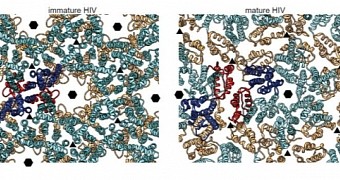In a paper published in yesterday's issue of the journal Nature, researchers with the European Molecular Biology Laboratory in Germany detail how, using a technology known as cryo-electron microscopy, they managed to study the anatomy of an immature form of HIV in unprecedented detail.
This detailed structure of an immature form of HIV, documented in the image accompanying this article and in the video below, is argued to be the first ever to show exactly where each of the building blocks that form the virus sits.
Interestingly enough, the specialists behind this research project say that, contrary to their expectations, the immature form of HIV was found to look nothing like other viruses that closely resemble the mature HIV virus.
“The structure is definitely different from what we’d expected,” specialist John Briggs said in a statement. “We assumed that retroviruses like HIV and Mason-Pfizer Monkey Virus would have similar structures, because they use such similar building blocks, but it turns out that their immature forms are surprisingly different from each other,” he added.
Writing in the journal Nature, the specialists behind this research project explain that, having entered the human body, the HIV virus goes on to infect cells of the immune system and to produce copies of itself using their components.
The thing is that, when leaving an infected cell inside which they were formed, these copies of the HIV virus are still immature. It is only later that they alter their structure, become mature and go on to infect other cells.
Scientists hope that, now that they have a better idea of what the HIV virus looks like while still in its infancy, they will be able to develop better drugs intended to destroy it before it matures.

 14 DAY TRIAL //
14 DAY TRIAL // 